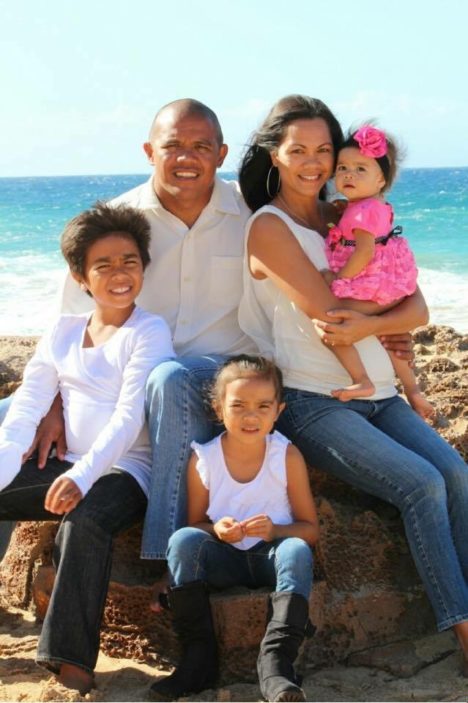Molokai Couple Publishes Children’s Book

Photo courtesy of Kananikala Bishaw-Juario
A husband and wife team from Molokai took on the task of creating their own children’s book to fill a void they discovered as parents. “Haloa the Little Huli,” written by Kananikala Bishaw-Juario and illustrated by Kyle Ikaika Bishaw-Juario, was written to help teach local children about the process of making poi.
“We actually wrote the story to teach our kids’ preschool [class] how to make poi,” said Kananikala. “I couldn’t find a book that would catch their attention, so I started writing this book just to show them what other kinds of plants we have in Hawaii and what we use them for. But the main focus was haloa.”
The book, inspired by their children and the children of Molokai, tells the story of Haloa the Little Huli, who wants to do his part to make a lu`au in Halawa Valley a success. As he grows in the lo`i, he sees many of his friends, including a kukui nut tree, a koa tree, and a ti leaf plant, all playing an important role in the lu`au, and he pines for the time to come when he, too, can be useful.
“This is the plant that, from the legend, sprouted to take care of the Hawaiian people,” said Kananikala. “So that’s what I wanted them to grasp from the book was, ‘You’re small right now. And you don’t see much that you can do. But if you wait and you have a good heart, and you want to bless people, then eventually, you are gonna grow up and you will do all the things that you dream to do.’”
Kananikala, who works in the physical therapy department for Molokai Hospital, and Ikaika, a police officer on Molokai, began writing the book about six years ago when they were invited by their son Nathan’s preschool to teach the children there about making poi.
“I wrote it in about three days,” explained Kananikala, “and then he did the illustrations in about two days, and we colored them all in with crayons and put them on poster board.”
The original story was only about 10 pages, and the couple used the storyboards several times over the years whenever they were invited to teach local children about poi making. As time passed, they built upon the story, until they had the makings of the final book.
The two are often asked to present on taro and poi making due to their experiences working in the lo`i in Halawa Valley.
“When my daughter was born, my hanai grandfather from Halawa [Pilipo Solatorio], gave us a section of the lo`i and that was our kuleana, our responsibility, and we had to take care of it.” said Ikaika. “So we cleaned it out, we opened it up, we planted the taro and we took care of it for about a year. And when we had our daughter’s first baby party, we harvested the taro to have the poi for the party.”
Ikaika spoke passionately about the vital role that the tutelage and stories of Pilipo and his wife Dianna Solatorio played not only in his life, but in the development of the book.
“The best resource we have is the people we know,” he said. “That’s our best resource. The people who have carried the information and the knowledge. A book is awesome, but to actually talk to somebody who’s lived it is priceless.”
Kananikala, who has never written any other books, said that she had seen other books for children about haloa, but most of them were focused on the legends, and didn’t really illustrate the hands-on process of poi making in a way that preschoolers could follow.
After presenting the story several times in classrooms throughout Molokai, teachers and friends encouraged the couple to publish the book. Their friend, Matt Yamashita, then suggested self-publishing the book through a program called Createspace, and making it available on Amazon. The couple received help with editing and formatting from graphic designer Laura Pilz, who used to live on Molokai, and assistance with Hawaiian language from Henohea Linker. They are currently considering different ways that they might use the book as part of a larger poi-making curriculum for schools around the state, but, for now, the Bishaw-Juarios agree that the most rewarding part of writing and illustrating their first book is sharing the book with the children of Molokai.
“When we go out and read it to the kids, they can relate to Haloa in a lot of ways,” said Kananikala. “When you first open it, they know where this is, especially on Molokai, they’re like ‘That’s Halawa Valley aunty!’ and they can’t believe there’s a book about it.”
The Bishaw-Juarios will be holding their first book signing on Wednesday, May 3, at the Molokai Public Library at 5:30 p.m., as part of the Read to Me program. The book is currently available on Amazon.











Don't have a Molokai Dispatch ID?
Sign up is easy. Sign up now
You must login to post a comment.
Lost Password